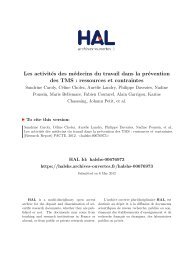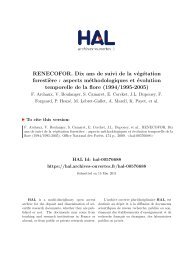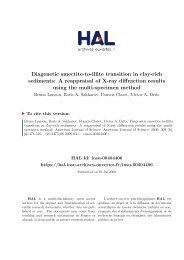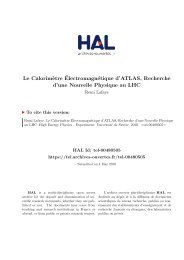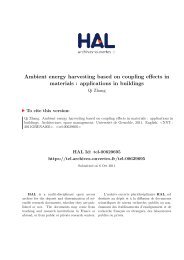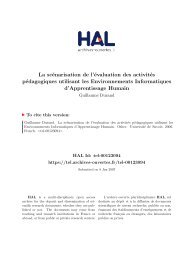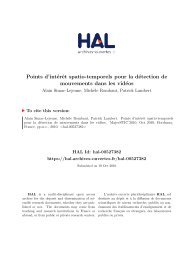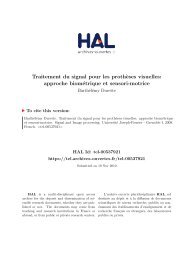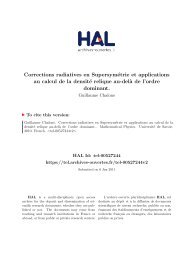Modélisation, analyse mathématique et numérique de divers ...
Modélisation, analyse mathématique et numérique de divers ...
Modélisation, analyse mathématique et numérique de divers ...
You also want an ePaper? Increase the reach of your titles
YUMPU automatically turns print PDFs into web optimized ePapers that Google loves.
viii<br />
Table <strong>de</strong>s matières<br />
Partie II Autour <strong>de</strong>s Équations Primitives Compressibles<br />
Chapitre 3 Existence <strong>et</strong> stabilités <strong>de</strong> solutions faibles 133<br />
3.1 Introduction . . . . . . . . . . . . . . . . . . . . . . . . . . . . . . . . . . . . . . . . . . . . . . 134<br />
3.1.1 Contexte physique. . . . . . . . . . . . . . . . . . . . . . . . . . . . . . . . . . . . . . . 135<br />
3.1.2 Contexte mathématique. . . . . . . . . . . . . . . . . . . . . . . . . . . . . . . . . . . . 136<br />
3.2 Dérivation formelle <strong>de</strong>s EPCs . . . . . . . . . . . . . . . . . . . . . . . . . . . . . . . . . . . . 138<br />
3.2.1 Équations <strong>de</strong> Navier-Stokes compressibles anisotropes . . . . . . . . . . . . . . . . . . 139<br />
3.2.2 Analyse asymptotique formelle <strong>et</strong> les EPCs . . . . . . . . . . . . . . . . . . . . . . . . 140<br />
3.3 Un résultat d’existence <strong>de</strong> solutions faibles pour les EPCs en dimension <strong>de</strong>ux . . . . . . . . . 142<br />
3.3.1 Preuve du résultat d’existence . . . . . . . . . . . . . . . . . . . . . . . . . . . . . . . . 143<br />
3.3.2 Preuve du résultat d’existence <strong>de</strong> B. V. Gatapov <strong>et</strong> A. V. Kazhikhov . . . . . . . . . . 145<br />
3.4 Un résultat <strong>de</strong> stabilité <strong>de</strong> solutions faibles pour les EPCs en dimension trois . . . . . . . . . 150<br />
3.4.1 Étu<strong>de</strong> <strong>de</strong> la stabilité <strong>de</strong> solutions faibles du modèle intermédiaire . . . . . . . . . . . . 152<br />
3.4.2 Étu<strong>de</strong> <strong>de</strong> la stabilité <strong>de</strong> solutions faibles pour les EPCs . . . . . . . . . . . . . . . . . . 161<br />
3.5 Perspectives . . . . . . . . . . . . . . . . . . . . . . . . . . . . . . . . . . . . . . . . . . . . . . 161<br />
Partie III Travaux en cours <strong>et</strong> perspectives<br />
Chapitre 4 Vers la cavitation<br />
4.1 La cavitation . . . . . . . . . . . . . . . . . . . . . . . . . . . . . . . . . . . . . . . . . . . . . 166<br />
4.1.1 Historiquement . . . . . . . . . . . . . . . . . . . . . . . . . . . . . . . . . . . . . . . . 166<br />
4.1.2 Apparition <strong>et</strong> les différentes formes <strong>de</strong> cavitation . . . . . . . . . . . . . . . . . . . . . 167<br />
4.1.3 Modélisation mathématique <strong>de</strong> la cavitation . . . . . . . . . . . . . . . . . . . . . . . . 169<br />
4.1.4 Perspectives . . . . . . . . . . . . . . . . . . . . . . . . . . . . . . . . . . . . . . . . . . 173<br />
4.2 Entrainement d’air dans une conduite fermée : approche bi-couche . . . . . . . . . . . . . . . 174<br />
4.2.1 Un modèle bicouche air/eau . . . . . . . . . . . . . . . . . . . . . . . . . . . . . . . . . 175<br />
4.2.2 La formulation cinétique . . . . . . . . . . . . . . . . . . . . . . . . . . . . . . . . . . . 181<br />
4.2.3 Le schéma cinétique . . . . . . . . . . . . . . . . . . . . . . . . . . . . . . . . . . . . . 182<br />
4.2.4 Tests numériques . . . . . . . . . . . . . . . . . . . . . . . . . . . . . . . . . . . . . . . 183<br />
4.2.5 Perspectives . . . . . . . . . . . . . . . . . . . . . . . . . . . . . . . . . . . . . . . . . . 191<br />
Chapitre 5 Modélisation <strong>de</strong> la sédimentation<br />
5.1 Introduction . . . . . . . . . . . . . . . . . . . . . . . . . . . . . . . . . . . . . . . . . . . . . . 194<br />
5.1.1 Les différents mo<strong>de</strong>s <strong>de</strong> transports <strong>de</strong> sédiments . . . . . . . . . . . . . . . . . . . . . . 194<br />
5.1.2 Un modèle mathématique : les équations <strong>de</strong> Saint-Venant-Exner . . . . . . . . . . . . . 195<br />
5.2 Dérivation formelle du modèle <strong>de</strong> mélange . . . . . . . . . . . . . . . . . . . . . . . . . . . . . 197<br />
5.2.1 Présentation <strong>de</strong>s modèles . . . . . . . . . . . . . . . . . . . . . . . . . . . . . . . . . . . 197<br />
5.2.2 Conditions aux limites . . . . . . . . . . . . . . . . . . . . . . . . . . . . . . . . . . . . 199<br />
5.2.3 Analyse dimensionnelle du modèle <strong>de</strong> base . . . . . . . . . . . . . . . . . . . . . . . . . 202<br />
5.2.4 Analyse asymptotique formelle . . . . . . . . . . . . . . . . . . . . . . . . . . . . . . . 203<br />
5.3 Dérivation formelle d’un modèle <strong>de</strong> transport <strong>de</strong> sédiments . . . . . . . . . . . . . . . . . . . . 205<br />
5.3.1 Analyse asymptotique <strong>de</strong> type couche mince . . . . . . . . . . . . . . . . . . . . . . . . 205<br />
5.3.2 Régime asymptotique . . . . . . . . . . . . . . . . . . . . . . . . . . . . . . . . . . . . . 209<br />
5.3.3 Intégration verticale du modèle <strong>de</strong> mélange . . . . . . . . . . . . . . . . . . . . . . . . 211<br />
5.4 Un premier exemple : le flux <strong>de</strong> transport diffusif <strong>de</strong> J-D. Zabsonré . . . . . . . . . . . . . . . 212<br />
5.5 Un <strong>de</strong>uxième exemple : le flux <strong>de</strong> transport <strong>de</strong> Grass . . . . . . . . . . . . . . . . . . . . . . . 215<br />
5.6 Perspectives . . . . . . . . . . . . . . . . . . . . . . . . . . . . . . . . . . . . . . . . . . . . . . 215<br />
Annexes 217<br />
Annexe A Produits non-conservatifs 217<br />
Annexe B La métho<strong>de</strong> <strong>de</strong>s tuyaux équivalents 219<br />
Annexe C Lemme d’Aubin-Simon <strong>et</strong> injections <strong>de</strong> Sobolev 221



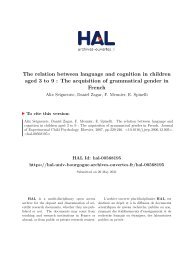
![[inria-00494734, v1] Genèse et estimation d'un modèle de ... - HAL](https://img.yumpu.com/50826406/1/184x260/inria-00494734-v1-genase-et-estimation-dun-modale-de-hal.jpg?quality=85)

